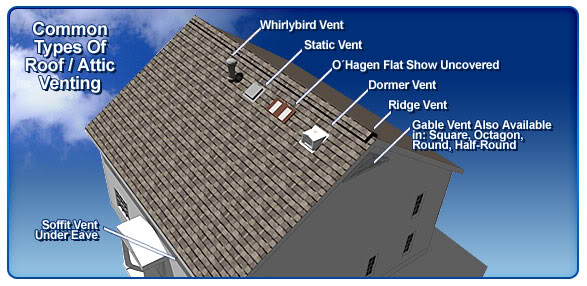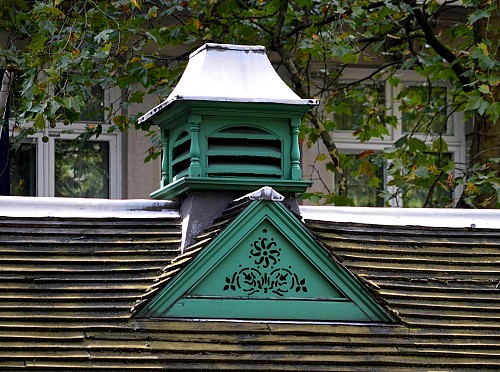Roof Vents or Attic Vents
Roof vents, also called attic vents, provide air flow and ventilation in your attic. Roof vents are critical for the proper functioning of your entire home for several reasons. They increase the life of your roofing, and permit proper functioning of your heating and air conditioning system (HVAC). Improper or insufficient ventilation promotes mold growth in your home (from all the locked-in moisture), which may lead to serious health problems. Poor ventilation also means higher energy costs -- in other words, higher bills. So find out what attic vents are all about and how they can help you and your family have a healthy, energy-saving home.
Avoid moisture damage with proper roof ventilation
The Number 1 reason for roof replacements: damage caused by moisture. Approximately nine out of ten North American homes do not have proper attic ventilation. That's why it is crucial to find a professional roofer who knows all the ins and outs of roof ventilation -- correct number, ideal placement, etc. Don’t worry about compromising the look of your roof with roof vents; you'll find many shapes, sizes, and colors on the market that will go well with your home's style. There are 2 basic kinds of attic/roof vents: intake vents and exhaust vents.

Image: Energysavercooling.com
Intake Vents
Intake Vents are placed along the soffit to let fresh air into the attic. There are 3 common types, gable, static, and soffit intake vents:
1. Gable: This type of vent is popular but often least effective. They are installed in the gable wall below the peak of the roof and are available in several shapes and colors.
2. Static: Also known as eyebrow vents, these are made of a sheet metal cylinder with a flashing collar and a metal hood to keep rain out. They're installed in rows along the face of the roof by cutting holes in the roofing, nailing the flashing collars to the roof sheathing and shingling around the vents. Their effectiveness depends on how many are installed; their greatest disadvantage is that like any roof penetration, they may leak.
3. Soffit: Soffit vents are located under the eaves, right near where the gutters should be. They often have a screen over them to keep out insects and may be as long as 22". They are one of the easiest to install by cutting rectangular holes in the soffit and screwing the vent over the hole.
Exhaust Vents
Exhaust Vents are installed in the upper third of the roof to allow attic air to escape. There are 2 kinds, static vents and power ventilators:
1. Static vents include ridge vents and allow the air to escape. Ridge vents are considered the most efficient and cost-effective.
2. Power ventilators suck out air from the attic. They are turbine vents that consist of a turbine mounted on a sheet-metal cylinder. They are installed like roof line vents along the face of the roof. When the wind blows, it spins the turbine, which in turn draws air up out of the attic. Their effectiveness, naturally, depends on whether the wind is blowing or not.
Consult an experienced roofing contractor about the best type of roof vents for your home.
Updated January 15, 2018.
Looking for a Pro? Call us (866) 441-6648

Roofing Average Costs
Roofers Experiences

Siding And Roof Replacement By The Same Contractor

Repair For Cedar Siding Battered By Ocean Winds And Woodpeckers




